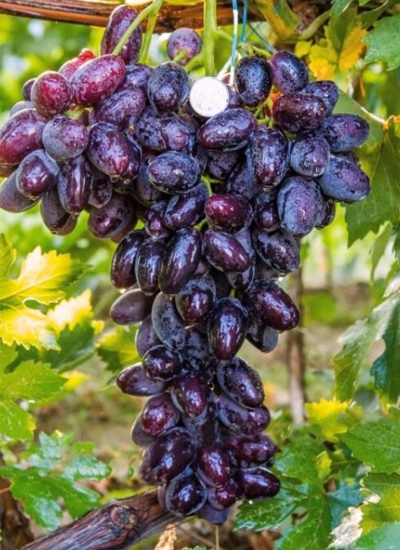
- Authors: selection of V.M. Kalugin
- Berry color: red-purple
- Taste: harmonious
- Ripening period: early
- Ripening period, days: 110-120
- Frost resistance, ° C: -23
- Bunch weight, g: 800-2000
- Density of the bunch: medium
- Berry shape: oval-conical with a blunt tip
- Berry size, mm: 52x30
The grapes prefer warmth and need constant care. Good fertile soil, supports and comfortable climatic conditions contribute to a rich harvest. Breeders are developing new varieties adapted to adverse factors and diseases. One of these varieties is Emir.
Breeding history
The country of origin is Ukraine. In the Zaporozhye region, in the village of Dnepropetrovka, breeder Viktor Mikhailovich Kalugin bred a hybrid variety Emir.
Geography of distribution
Emir grapes grows in many regions of Ukraine and shows excellent results.
Description
The Emir grape variety is tall, medium leafy. Leaves are light green. Sapling type - self-rooted. The plant has the first signal fruiting. It is considered one of the best marketable forms of the hybrid.
Ripening period
Emir belongs to the early varieties. The ripening period lasts only 110-120 days. In the last decade of August, it is usually already possible to harvest.
Bunches
The density of the brush is average, it weighs 800-2000 grams. The shape of the bunch is cylindrical.
Berries
Large berries look very beautiful, as if they are not real. The size of one berry is 52x30 mm. The color of the grapes is red-violet, the closer the ripening period, the richer the color. Emir's shape is elongated, oval-conical with a blunt tip. The berry weighs 20–35 grams. Even in the rainy season, the fruits of the Emir do not crack from excess moisture.
Taste
The crispy flesh has a harmonious taste. The fruits of this variety, which are not ripe near the tail, have a pleasant taste. Emir differs from his other brothers by high sugar accumulation.
Yield
The new variety is high-yielding. The strong branches of the vines sag under the multitude of bunches strewn with grapes.


Growing features
Able to bear fruit on young, thin shoots. Fruit bud laying is good. The next year, a strengthened plant will delight you with abundant fruiting. The lignification of the vine is fast.
Landing
Grows well in lowlands with sufficient soil moisture. At the originator, the Emir grows in the place where the river once flowed. The plant is demanding on sunlight. Grapes are a freedom-loving plant and do not like tightness, so it is recommended to dig a bigger hole. Usually planted in the spring, between the bushes they leave from 1.5 to 2 meters, and between the rows - 3 meters.

Pollination
The hybrid form of Emir is self-pollinated. No additional pollination work is required.
Pruning
It is necessary to carry out pruning every year, remove dry, aching branches.
In autumn, the procedure is carried out after harvesting. Young green shoots that have not had time to ripen are removed. The green part of the vine is pruned with a small brown part of the already mature vine.
In the summer, they get rid of dry, excess branches and some of the foliage so as not to shade the plant.
The artificial formation of a vine in the form of a quadrangular fan is of great importance.

Watering
After planting, the bush needs watering. Water at least 4 times per season.
First in the spring.
Then before flowering.
Then, when the grapes begin to ripen and change in color.
The last time is before the winter period in November.
Rainy weather eliminates the need for additional watering.


Top dressing
Before planting, you need to add humus so that the seedling forms a powerful root system. This procedure should not be ignored if you want to grow a strong, well-developed plant. Add 2 kg of ash, 0.5 kg of nitroammophoska, 1 bucket of earth to a bucket of cattle manure.
Frost resistance and the need for shelter
Emir easily tolerates a drop in temperature down to –23 ° С. In harsher climates, it is best to cover with agrofibre to avoid damaging the vines.

Diseases and pests
The variety is resistant to many diseases and pests, especially in the first years of cultivation. But you still need to take preventive measures twice with special drugs. Disease resistance 2.5-3.0 points.

If a grape is exposed to any disease or insect, this always affects its appearance.
Storage
A healthy product is best consumed fresh. The dense skin protects the grape pulp and extends the shelf life up to 2 months in a cool place. This skin is easy to chew and does not interfere with enjoying the taste of the grapes. Wasps do not harm the fruit. Berries of the Emir variety are suitable for making homemade wine and juices. High transportability.
Review overview
Experienced growers are pleased with the new variety. The berries remain large and do not shrink in the following seasons. A rich harvest allows you to enjoy fresh grapes and prepare supplies for future use.











































































